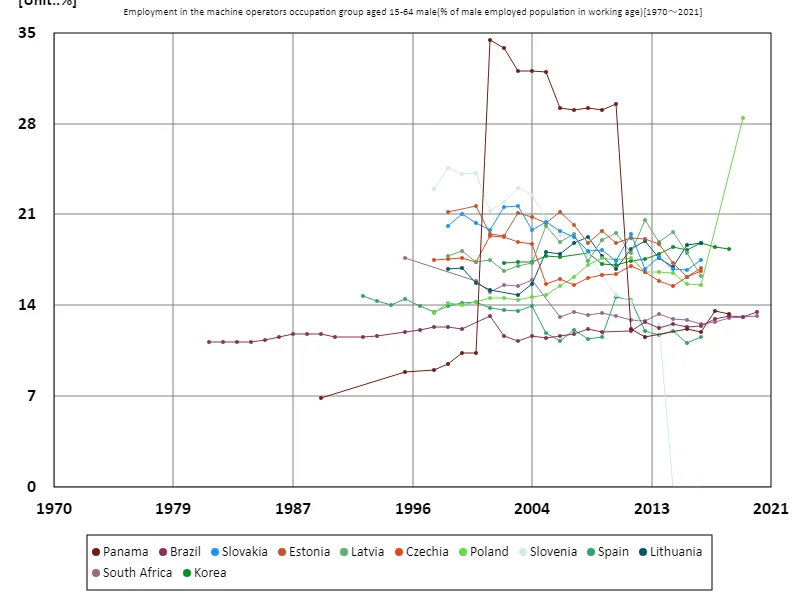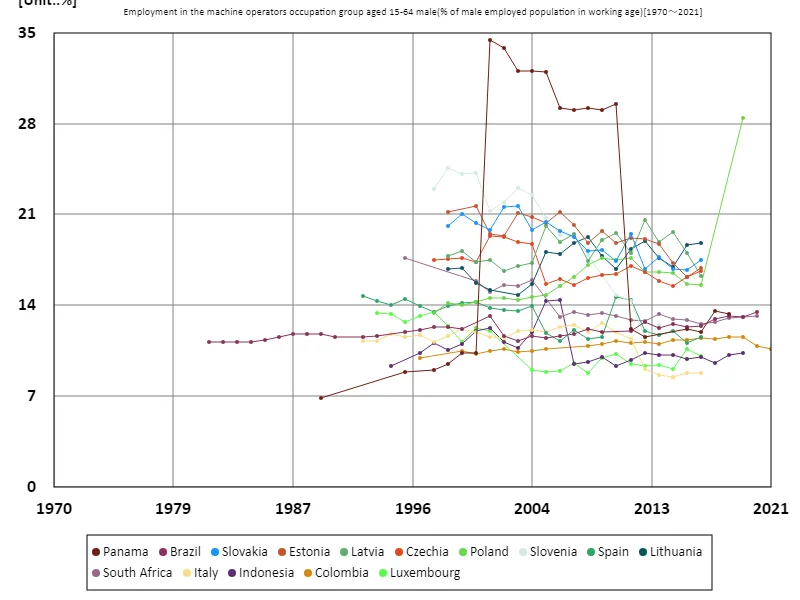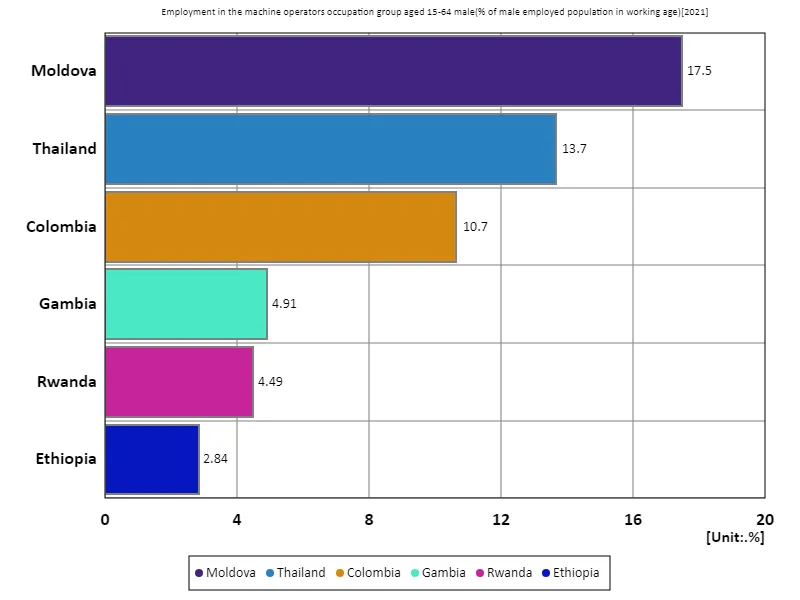- Abstract
- Employment rate of machine operators among men aged 15-64 (percentage of working-age males in the employed population)
- Employment rate of machine operators among men aged 15-64 (percentage of working-age male employed population) (Worldwide)
- Employment rate of machine operators for men aged 15-64 (percentage of working-age male employed population) (World, latest year)
- Reference
Abstract
According to 2020 data, in Brazil, the proportion of men aged 15 to 64 working as machine operators is high at 13.5%, indicating that the industrial structure has a strong demand for machine operators. Brazil’s economy relies heavily on mechanical operations, including manufacturing, heavy industry and mining, so many jobs are concentrated in this occupation. In contrast, the proportion of machine operators in developed countries tends to be relatively low. In these countries, technological innovation and automation are driving demand for technicians and managers rather than machine operators. Additionally, technological advances are changing the role of the machine operator. For example, advances in AI and robotics are creating a demand for personnel with more advanced skills. Brazil’s high employment rate therefore reflects the labor market’s continued reliance on traditional machine operations, and the impact of technological change as the economy grows in the future will be of interest.
Employment rate of machine operators among men aged 15-64 (percentage of working-age males in the employed population)
Looking back at data from 1981 to 2020, employment rates for machine operators show widely varying trends across countries. In 2001, Panama recorded a high employment rate of 34.4%, which has continued to increase since then and currently stands at 38.6%. Panama’s high employment rate is due to rapid economic development and progress in manufacturing and infrastructure. From the 1980s through the early 2000s, Panama’s economy saw a surge in demand for machine operators due to large construction projects and a drive towards industrialization. In contrast, in developed countries, technological innovation and the expansion of the service industry have led to a gradual decline in the employment rate of machine operators. In these countries, the demand for technical and managerial positions has increased and the role of machine operators has changed. Additionally, in emerging and developing countries, the demand for machine operators continues to increase along with economic growth. As a result, countries like Panama saw their employment rates for machine operators peak and remain high ever since.


The maximum is 34.4%[2001] of Panama, and the current value is about 38.6%
Employment rate of machine operators among men aged 15-64 (percentage of working-age male employed population) (Worldwide)
Based on data from 1981 to 2021, employment rates for machine operators vary widely across countries. In particular, in 2001, Panama recorded a high employment rate of machine operators at 34.4%, and the rate has continued to increase since then, reaching 38.6% in 2021. The increase reflects rising demand for machinery operations, including manufacturing and construction, as Panama advances its economic development and industrialization. However, developed countries have seen a notable decline in employment rates for machine operators over this period. Technological innovation and increased automation have transformed the role of machine operators in many developed countries, increasing the demand for more highly skilled and managerial roles. This has led to a decline in employment rates for machine operators. In contrast, developing and emerging countries are likely to see an increased demand for machine operators as their economies grow and industrialize. In these countries, employment of machine operators has increased as a result of progress in industrialization and infrastructure development, and the employment rate remains at a high level. The example of Panama is an example of this trend and shows how the stage of economic development and industrial structure have a significant impact on employment rates of machine operators.


The maximum is 34.4%[2001] of Panama, and the current value is about 38.6%
Employment rate of machine operators for men aged 15-64 (percentage of working-age male employed population) (World, latest year)
According to 2021 data, Moldova has the highest employment rate for male machine operators aged 15-64 at 17.5%, compared to an overall average of 9.01% and a total employment rate of 54.1%. The figures show that the role of a machine operator varies widely across countries and regions. Moldova’s high employment rate is due to a relatively high demand for machine operators, as a large part of its economy is dependent on manufacturing and construction. In these countries, the labour market is mainly driven by industrial activity, with machine operators playing a key role. Meanwhile, the overall average of 9.01% reflects technological innovation and changes in industrial structure in developed and emerging countries. In developed countries, automation and digitalization are on the rise, which is likely to reduce the demand for machine operators. Additionally, with the demand for technical skills increasing, we are seeing a shift from machine operators to technicians and management roles. Overall, the employment rate of machine operators depends heavily on the stage of economic development and industrial structure, remaining high in developing countries while tending to decline in developed countries. Thus, employment rates for machine operators reflect local economic conditions and the impact of technological change.


The maximum is 17.5% of Moldova, the average is 9.01%, and the total is 54.1%



Comments